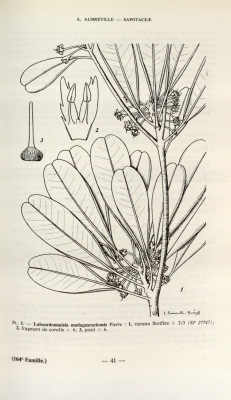Labourdonnaisia madagascariensis
Pierre ex Baill.
Sapotaceae
Common Name:
General Information
Labourdonnaisia madagascariensis is a tree that can grow up to 10 metres tall[
299- Title
- Protabase - Plant Resources of Tropical Africa.
- Publication
-
- Author
-
- Website
- http://www.prota.org
- Publisher
-
- Year
- 0
- ISBN
-
- Description
- An excellent on-line database with detailed information on over 3,200 species of useful plants of Africa.
].
The plant is harvested from the wild for local use as a medicine and source of wood.
Known Hazards
None known
Botanical References
455- Title
- Flore de Madagascar et des Comores
- Publication
-
- Author
- Humbert H.
- Website
- http://www.biodiversitylibrary.org/
- Publisher
- Museum National D'Histoire Naturelle; Paris
- Year
- 1946 - 1984
- ISBN
-
- Description
- Written in French, an excellent flora of the area though it has not been completed. Available for download from the Internet.
Range
Africa - eastern Madagascar.
Habitat
Humid evergreen coastal forest on sandy soils[
299- Title
- Protabase - Plant Resources of Tropical Africa.
- Publication
-
- Author
-
- Website
- http://www.prota.org
- Publisher
-
- Year
- 0
- ISBN
-
- Description
- An excellent on-line database with detailed information on over 3,200 species of useful plants of Africa.
,
455- Title
- Flore de Madagascar et des Comores
- Publication
-
- Author
- Humbert H.
- Website
- http://www.biodiversitylibrary.org/
- Publisher
- Museum National D'Histoire Naturelle; Paris
- Year
- 1946 - 1984
- ISBN
-
- Description
- Written in French, an excellent flora of the area though it has not been completed. Available for download from the Internet.
].
Properties
| Medicinal Rating |      |
| Other Uses Rating |      |
| Habit | Tree |
| Height | 8.00 m |
| Cultivation Status | Wild |
Cultivation Details
Found in the wild on sandy soils[
455- Title
- Flore de Madagascar et des Comores
- Publication
-
- Author
- Humbert H.
- Website
- http://www.biodiversitylibrary.org/
- Publisher
- Museum National D'Histoire Naturelle; Paris
- Year
- 1946 - 1984
- ISBN
-
- Description
- Written in French, an excellent flora of the area though it has not been completed. Available for download from the Internet.
].
Edible Uses
None known
Medicinal
Bark decoctions of all Labourdonnaisia species are astringent and used to treat haemorrhages and menstrual problems[
299- Title
- Protabase - Plant Resources of Tropical Africa.
- Publication
-
- Author
-
- Website
- http://www.prota.org
- Publisher
-
- Year
- 0
- ISBN
-
- Description
- An excellent on-line database with detailed information on over 3,200 species of useful plants of Africa.
].
The bark of Labourdonnaisia madagascariensis contains tannin[
299- Title
- Protabase - Plant Resources of Tropical Africa.
- Publication
-
- Author
-
- Website
- http://www.prota.org
- Publisher
-
- Year
- 0
- ISBN
-
- Description
- An excellent on-line database with detailed information on over 3,200 species of useful plants of Africa.
].
Additional compounds such as phenols, leucoanthocyanins, anthraquinones, terpenes, alkaloids and saponins have been detected in the bark and leaves of other Labourdonnaisia species, and it is likely that similar compounds also occur in Labourdonnaisia madagascariensis[
299- Title
- Protabase - Plant Resources of Tropical Africa.
- Publication
-
- Author
-
- Website
- http://www.prota.org
- Publisher
-
- Year
- 0
- ISBN
-
- Description
- An excellent on-line database with detailed information on over 3,200 species of useful plants of Africa.
].
Other Uses
The bark of Labourdonnaisia madagascariensis is used for dyeing silk and cotton tissues red. Occasionally, the bark is also used for tanning[
299- Title
- Protabase - Plant Resources of Tropical Africa.
- Publication
-
- Author
-
- Website
- http://www.prota.org
- Publisher
-
- Year
- 0
- ISBN
-
- Description
- An excellent on-line database with detailed information on over 3,200 species of useful plants of Africa.
].
The harvested bark is dried and pulverized. The powder is put in boiling water, together with the fibres or textiles to be dyed. After 2 days of boiling, the red dyed fibres or textiles are taken out and dried in the sun[
299- Title
- Protabase - Plant Resources of Tropical Africa.
- Publication
-
- Author
-
- Website
- http://www.prota.org
- Publisher
-
- Year
- 0
- ISBN
-
- Description
- An excellent on-line database with detailed information on over 3,200 species of useful plants of Africa.
].
In another method, part of the bark is broken into small pieces, which are tied together, and another part is pulverized. The pieces and the powder are put in a container with water. The container is heated until boiling in the morning and in the evening and this is repeated for up to 8 days until the dye bath has obtained the desired red colour. Then the bark pieces are taken out and replaced by the fibre or textiles. This mixture is heated again and when the fibre or textile has obtained the right colour it is taken out and dried. If necessary the same operation is repeated a second time[
299- Title
- Protabase - Plant Resources of Tropical Africa.
- Publication
-
- Author
-
- Website
- http://www.prota.org
- Publisher
-
- Year
- 0
- ISBN
-
- Description
- An excellent on-line database with detailed information on over 3,200 species of useful plants of Africa.
].
Propagation
Seed -
If you have any useful information about this plant, please leave a comment. Comments have to be approved before they are shown here.


 Useful Tropical Plants Database 2014 by
Ken Fern,
web interface by
Ajna Fern
with help from
Richard Morris.
Useful Tropical Plants Database 2014 by
Ken Fern,
web interface by
Ajna Fern
with help from
Richard Morris.